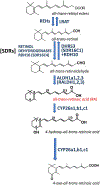Vitamin A and retinoid signaling in the kidneys
- PMID: 37331524
- PMCID: PMC10528136
- DOI: 10.1016/j.pharmthera.2023.108481
Vitamin A and retinoid signaling in the kidneys
Abstract
Vitamin A (VA, retinol) and its metabolites (commonly called retinoids) are required for the proper development of the kidney during embryogenesis, but retinoids also play key roles in the function and repair of the kidney in adults. Kidneys filter 180-200 liters of blood per day and each kidney contains approximately 1 million nephrons, which are often referred to as the 'functional units' of the kidney. Each nephron consists of a glomerulus and a series of tubules (proximal tubule, loop of Henle, distal tubule, and collecting duct) surrounded by a network of capillaries. VA is stored in the liver and converted to active metabolites, most notably retinoic acid (RA), which acts as an agonist for the retinoic acid receptors ((RARs α, β, and γ) to regulate gene transcription. In this review we discuss some of the actions of retinoids in the kidney after injury. For example, in an ischemia-reperfusion model in mice, injury-associated loss of proximal tubule (PT) differentiation markers occurs, followed by re-expression of these differentiation markers during PT repair. Notably, healthy proximal tubules express ALDH1a2, the enzyme that metabolizes retinaldehyde to RA, but transiently lose ALDH1a2 expression after injury, while nearby myofibroblasts transiently acquire RA-producing capabilities after injury. These results indicate that RA is important for renal tubular injury repair and that compensatory mechanisms exist for the generation of endogenous RA by other cell types upon proximal tubule injury. ALDH1a2 levels also increase in podocytes, epithelial cells of the glomeruli, after injury, and RA promotes podocyte differentiation. We also review the ability of exogenous, pharmacological doses of RA and receptor selective retinoids to treat numerous kidney diseases, including kidney cancer and diabetic kidney disease, and the emerging genetic evidence for the importance of retinoids and their receptors in maintaining or restoring kidney function after injury. In general, RA has a protective effect on the kidney after various types of injuries (eg. ischemia, cytotoxic actions of chemicals, hyperglycemia related to diabetes). As more research into the actions of each of the three RARs in the kidney is carried out, a greater understanding of the actions of vitamin A is likely to lead to new insights into the pathology of kidney disorders and the development of new therapies for kidney diseases.
Keywords: Acute kidney injury; Chronic kidney disease; Diabetic kidney disease; Fibrosis; Polycystic kidney disease; Proximal tubule injury; Retinoic acid; Retinoic acid receptor.
Copyright © 2023 Elsevier Inc. All rights reserved.
Conflict of interest statement
Declaration of Competing Interest The authors have no conflicts of interest with respect to this publication.
Figures



Similar articles
-
Management of urinary stones by experts in stone disease (ESD 2025).Arch Ital Urol Androl. 2025 Jun 30;97(2):14085. doi: 10.4081/aiua.2025.14085. Epub 2025 Jun 30. Arch Ital Urol Androl. 2025. PMID: 40583613 Review.
-
Short-Term Memory Impairment.2024 Jun 8. In: StatPearls [Internet]. Treasure Island (FL): StatPearls Publishing; 2025 Jan–. 2024 Jun 8. In: StatPearls [Internet]. Treasure Island (FL): StatPearls Publishing; 2025 Jan–. PMID: 31424720 Free Books & Documents.
-
The Black Book of Psychotropic Dosing and Monitoring.Psychopharmacol Bull. 2024 Jul 8;54(3):8-59. Psychopharmacol Bull. 2024. PMID: 38993656 Free PMC article. Review.
-
Systemic Inflammatory Response Syndrome.2025 Jun 20. In: StatPearls [Internet]. Treasure Island (FL): StatPearls Publishing; 2025 Jan–. 2025 Jun 20. In: StatPearls [Internet]. Treasure Island (FL): StatPearls Publishing; 2025 Jan–. PMID: 31613449 Free Books & Documents.
-
Sexual Harassment and Prevention Training.2024 Mar 29. In: StatPearls [Internet]. Treasure Island (FL): StatPearls Publishing; 2025 Jan–. 2024 Mar 29. In: StatPearls [Internet]. Treasure Island (FL): StatPearls Publishing; 2025 Jan–. PMID: 36508513 Free Books & Documents.
Cited by
-
Pericytes recruited by CCL28 promote vascular normalization after anti-angiogenesis therapy through RA/RXRA/ANGPT1 pathway in lung adenocarcinoma.J Exp Clin Cancer Res. 2024 Jul 29;43(1):210. doi: 10.1186/s13046-024-03135-3. J Exp Clin Cancer Res. 2024. PMID: 39075504 Free PMC article.
-
Association of the retinol to all-trans retinoic acid pathway with autism spectrum disorder.World J Pediatr. 2024 Oct;20(10):1043-1058. doi: 10.1007/s12519-024-00815-0. Epub 2024 May 24. World J Pediatr. 2024. PMID: 38789720
-
Structure-Activity Relationships and Therapeutic Applications of Retinoids in View of Potential Benefits from Drug Repurposing Process.Biomedicines. 2024 May 10;12(5):1059. doi: 10.3390/biomedicines12051059. Biomedicines. 2024. PMID: 38791021 Free PMC article. Review.
-
Vitamin A mediates FABP4 to regulate intramuscular fat production: a new target and strategy for optimizing beef quality.BMC Genomics. 2025 Apr 24;26(1):397. doi: 10.1186/s12864-025-11544-7. BMC Genomics. 2025. PMID: 40275134 Free PMC article.
-
Retinoic acid receptor α activity in proximal tubules prevents kidney injury and fibrosis.Proc Natl Acad Sci U S A. 2024 Feb 13;121(7):e2311803121. doi: 10.1073/pnas.2311803121. Epub 2024 Feb 8. Proc Natl Acad Sci U S A. 2024. PMID: 38330015 Free PMC article.
References
-
- Aass N, De Mulder PH, Mickisch GH, Mulders P, van Oosterom AT, van Poppel H, Fossa SD, de Prijck L, & Sylvester RJ (2005). Randomized phase II/III trial of interferon Alfa-2a with and without 13-cis-retinoic acid in patients with progressive metastatic renal cell Carcinoma: the European Organisation for Research and Treatment of Cancer Genito-Urinary Tract Cancer Group (EORTC 30951). J Clin Oncol, 23, 4172–4178. - PubMed
-
- Agrawal S, He JC, & Tharaux PL (2021). Nuclear receptors in podocyte biology and glomerular disease. Nat Rev Nephrol, 17, 185–204. - PubMed
Publication types
MeSH terms
Substances
Grants and funding
LinkOut - more resources
Full Text Sources
Medical
Research Materials

